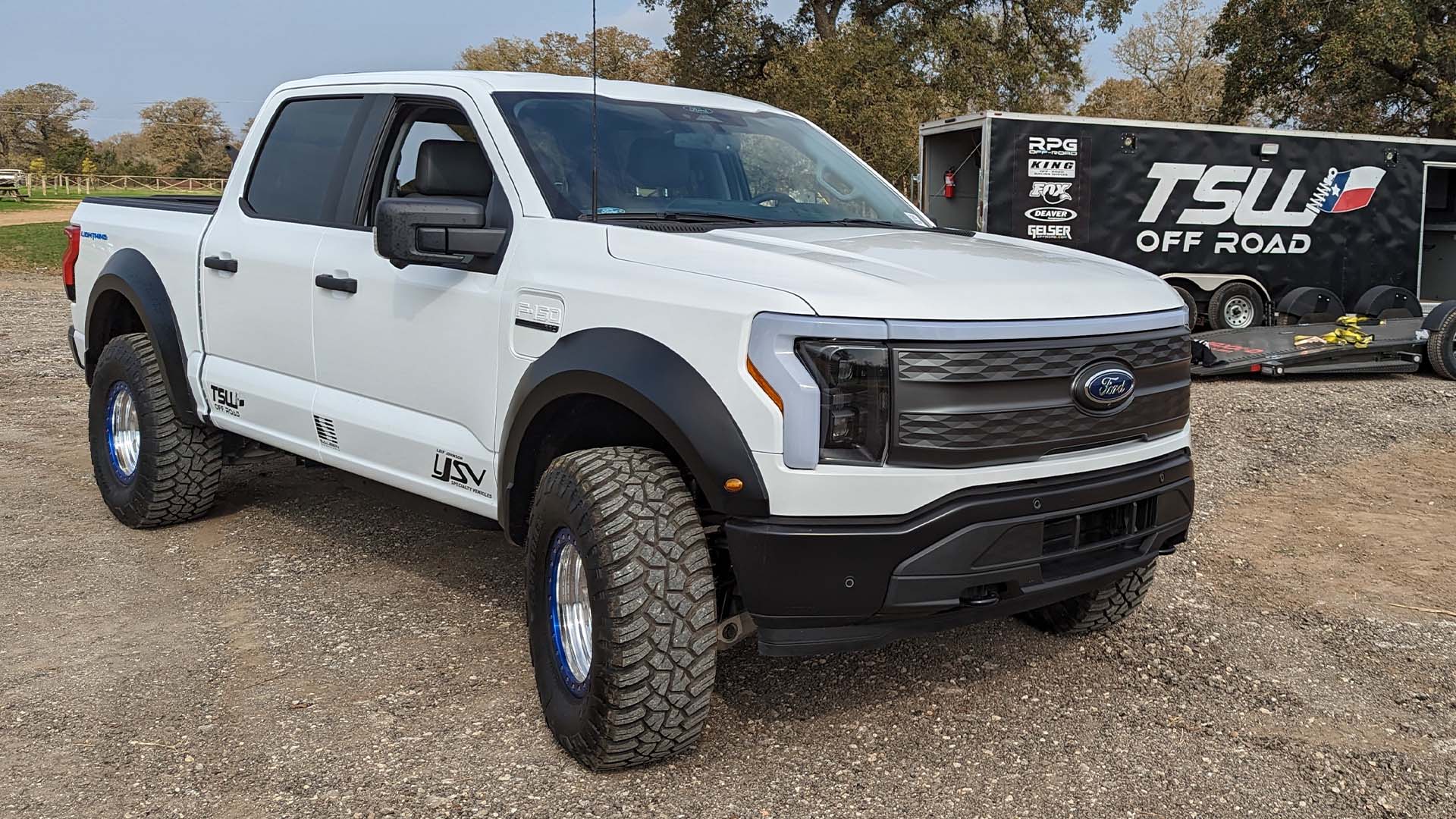

The Ford F-150 Lightning is superlative in lots of ways, which are mostly great. It’s extremely quick and extremely capable, but because of its four-wheel independent suspension, it’s also extremely difficult to modify for off-road performance. Some shops have thrown leveling kits on the front end, which helps to fit larger tires, but this “Raptor-swapped” F-150 Lightning may be the largest leap forward for the electric truck aftermarket.
It’s a collab between Leif Johnson Specialty Vehicles and TSW Off-Road, with the latter crafting a suspension setup that uses F-150 Raptor parts and completely custom hardware alike. They built the battery-powered pickup to look great, sure, but they put a real focus on legit performance metrics like suspension travel, dampening, and related attributes. That’s what sets it apart from the aesthetically pleasing yet comparatively tame F-150 Lightnings we’ve seen shops build already.
“A lot of people are under the assumption that these are all just bolt-on parts, which they’re not,” explained Alex Whitelaw, owner of TSW Off-Road, to The Drive. “To get it to work properly we had to do a lot of actual machining custom parts for the shocks and modifying the shocks, getting custom axles made, et cetera.”
Whitelaw estimates his shop put about 100 hours into building the suspension. They knew it wasn’t going to bolt up and ship out—the gas F-150 Raptor uses a solid rear axle with coil springs, for instance. As such, they were prepared to take lots of measurements and use their past experience with high-performance pickup mods to pull off the huge job.
“We had to make sure the frame was the same dimensions, that everything would fit—the control arms, the bolt pattern on the shocks,” Whitelaw continued. “As for the steering and the tie rods, the upper control arms, everything would have to be checked to make sure that parts would go on and that they’d actually cycle correctly. You can bolt all these suspension parts on but if they’re going to bind and not function properly, there’s no point.”





Whitelaw raises a valid concern here. Even if a less-seasoned shop were able to fab up new brackets and mounts, it’d all be for nothing if it fell apart the second you hit a sand berm. That’s where they endured a lot of trial and error, perfecting the setup so it handled like a true F-150 Raptor.
“We had to try three different shock combinations on the front until we found the correct travel length. Everything essentially did bolt up [in the front], except there was a huge hurdle we had to get figured out, which was the front axles. Because they’re electric motors, they’re not as wide as a traditional differential. We had to figure out the spline count, which ended up being the same as a Raptor. That was great; we just had to get significantly longer axles made to make it work.”
Revelations like this resulted in TSW Off-Road breaking new ground. Other shops haven’t messed with the F-150 Lightning’s front end as much, simply because they didn’t need to. It’s largely similar to a gas F-150 but when you’re transferring over high-performance parts that alter critical suspension geometry more than just a little, custom parts have to be made. This rig combines those custom-made 4130 chromoly axles with stock F-150 Raptor lower control arms, spindles, and tie rods with Saleen upper control arms.
“I think one or two people have already put leveling kits on there, which, y’know, you can put a bigger tire on there. That’s great, but the functionality is garbage,” Whitelaw said. “It’s not going to perform any better off-road. That’s the biggest difference of how it’s been done and what we did.”

Then there’s the weight concern. Whitelaw points out that, in their experience, overall poundage wasn’t an issue with the build. When kitted with the standard-range pack like the Pro model in question, the F-150 Lightning weighs 6,171 pounds according to Ford. Compare that to a crew-cab F-150 Raptor, which tips the scales at 5,740 pounds, and you’ll notice the difference isn’t that significant.
Instead, you have to focus on where the weight is at.
Whitelaw elaborated, “The weight distribution is where we had to make other changes as far as coil spring rates and dampening goes. You’ve got to remember, a typical F-150, the gas engine is up front and you have a 70/30 weight distribution; on a Lightning, it’s 50/50, essentially. All of your weight is in the center instead of the front, so we had to significantly go down in spring rate for the front coils and change the internal dampening, the valving of the shocks, accordingly.
“In the rear, we had to significantly go down in the spring rate because there’s a lot less leverage on the shock because of where it’s mounted. The shock is mounted essentially right above the axle line versus inward on the pendulum on a traditional IRS.”
So will they sell this as a kit? It’s tough to say. Whitelaw says if the demand is there, they “absolutely will.” Of course, it’ll come at a price as he says the Fox Factory Race Series 3.0 shocks alone cost somewhere between $7,000 and $8,000. Factor in the custom-made parts and labor, and you’re looking at something way more complex and expensive than a Rough Country lift.

For right now, it’s a one-off project that would take more work yet to replicate. Custom solutions like this will likely come in time as shops get more familiar with electric trucks writ large, but it’s hard to see them achieving cost parity with modifications to gas pickups anytime soon. That’s a bullet that enthusiasts will have to bite if they want the best of the best in electric truck off-road performance.
Got a tip or question for the author? Contact them directly: caleb@thedrive.com